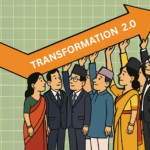The Fiscal Policy for Sustainable Development is an annual report published by the World Bank Group, which analyses Nepal’s development in areas of macro-fiscal context, federal expenditure, revenue generation, environmental fiscal policies and budget execution and investment management. The report, published on 1stDecember 2021 aims to identify factors that have hindered implementation and slowed development results. Hence, the report aims to align the development goals with the Green, Resilient and Inclusive Development (GRID) economy and provide recommendations on how institutional weakness and governance issues can be dealt with.
Nepal’s economic growth has been rapid and fared better than other low-income countries (LIC) like Afghanistan, Rwanda, and Ethiopia. However, political instability and the high dependence on India has resulted in high volatility in the growth trends.
The uncertain economic landscape in Nepal has not helped employment opportunities with around 93% of the workers being employed in informal jobs.
Nepal becoming a federal republic has resulted in the formation of national and subnational governments which have led to a rise in the government expenditure and fiscal deficit by 4.5 and 5.8 percentage points of GDP respectively. In addition, the COVID-19 pandemic has increased the burden of expenditure for relief and recovery purposes and led to a fall in tax revenue generation by 1.2 percentage points of GDP. This report, therefore, highlights the following as the key pillars that will help align fiscal policies with sustainable growth in the country.
Federal Expenditure
Nepal’s government expenditure has increased by 10 percentage points in the last decade. Transition to a federal system has seen a rise in intergovernmental transfers, employee compensations and social security expenses. While expenditure responsibilities were transferred from the central government to the subnational governments, revenue expenditure decisions were still made by the central government. The lack of decentralization of monetary power made these provincial and local governments (PLGs) limited in local expenditures.
As Nepal’s federal fiscal system is in a state of transition, the vertical distribution of resources needs to be streamlined. The report suggests that clearer norms must be established for effective delivery systems for the local governments. Clarification of the role of equalization grants will help in increasing regional expenditure on healthcare and education and earmarking conditional grants can help ensure a much more effective usage these grants. It further emphasized that a methodology to estimate regional fiscal needs can be developed to ensure the optimal utilization of government expenditure. The long-term goals should be aligned towards establishing policies to tackle conflicts between subnational governments and national ministries and provide a framework for regional bodies to access borrowings for infrastructural purposes.
Revenue
The report explains the country’s broad-based tax code[1], which applies taxes on majority of goods and services in the form of progressive corporate income taxes, personal income taxes, capital gains taxes, dividend taxes, value-added taxes (VAT), excise duty and import duties. This system ensures that the contribution of taxes to the revenue generation are distributed proportionally, hence lowering tax rates. However, inconsistent revenue collection has been seen at local levels due to the negligence of local tax laws and tax farming[2]. This along with the underuse of subnational tax sources is expected to pose a potential fiscal risk to Nepal.
The core discussion of the revenue section mentions that VAT, import duties and excise duties contributed to 21%, 19% and 7% of the total fiscal revenue of the country.
Nepal’s VAT exemptions on agricultural products, live animals, medical items, sale, and rental of buildings, etc. account for about 37% of the current revenue.
The report states that the exemptions have not been effective as the households have spent the same amount of their income on VAT. Similarly, Nepal’s tariff schedule puts higher rates on consumer products and lower rates on machinery and raw materials for production which gives firms less incentives to export products. Nepal’s upstream tariff costs system is detrimental for employment generation as most of the affected sectors are labor-intensive. Finally, corporate tax incentives in Nepal are directed towards attracting more investments in remote locations and facilitating labor-intensive manufacturing. However, these efforts have not helped in achieving the goal and the subsequent loss of total revenue to exemptions for institutional taxpayers has affected Nepal’s potential of generating higher corporate income taxes.
The immediate policy recommendations as suggested by the report is to maintain VAT exemptions which are aligned to the consumption basket of the economically weaker group and review the cost-effectiveness of corporate taxes. Nepal’s personal income tax revenue has been significantly below global averages in terms of productivity. Therefore, lowering the current exemption threshold of personal income taxes will generate higher taxes by bringing middle-income earners into the tax bracket. Raising tax rates on capital gains and dividends also need to be considered to prevent income shifting by high taxpayers.
Environmental Fiscal Policy
A section of the report was dedicated to the environmental policies and the risks associated with them. It highlights how biomass, which accounts for 71% of energy consumption in Nepal, remains one of the most traditional sources of energy in rural Nepal. However, monitoring biomass consumption remains difficult because most of the firewood and animal waste is procured independently, hence dodging the tax net. Therefore, reducing biomass requires the reduction of electricity tariffs to encourage induction stoves in household sector. Secondly, petroleum and coal, which account for 19% and 6% of energy consumption respectively, have custom duties and VATs which is collected and accounted for in the revenue collection. Finally, electricity, which accounts for only 45% of energy consumption, is largely generated from hydropower projects. Therefore, directing investments and facilitating the faster construction of hydro projects along with tax exemptions on electric vehicles will aid the country in moving away from the usage of petrol and diesel for transportation purposes.
Budget Execution
Nepal’s public debt levels have not been maintained and it was seen that Nepal’s average capital budget execution rate stood at only 75% compared to the LIC average of 86%. The report highlights that revenue collections are underspent to maintain and balance the rising fiscal deficits. This has led to halts in many capital and infrastructural projects. Higher than expected growth projections also disrupt the budget allocation process. The drivers of the budget under execution, as per the report, is the weak planning capacity and budget preparations of the mid-term expenditure framework (MTEF), misalignment among project preparation and budget, lack of qualified personnel in large infrastructural projects, land acquisition disputes and delay in the release of intergovernmental transfers. The report identifies the National Project Bank (NPB) as a key factor to help improve budget and maintain project planning standards in the country. Zero-based budgeting to avoid non-performing projects, aligning NPB with MTEF and a cost-benefit approach for efficient planning are some of the major objectives that the government could strive on achieving to structure the future roadmap for the country.
Conclusion
The Fiscal Policy for Sustainable Development Nepal report discusses the key challenges to Nepal as the country moves towards fiscal federalism and strives to align with fiscal sustainability goals. While this transition is a gradual process, the report helps in identifying the major challenges in terms of subnational governance, regional economic development, revenue generation potential, budget execution and environmental policies. Therefore, transparency in conditional and equalization grants, realization of the true VAT potential, pro-export policies, energy transition from biomass to electricity and the National Project Bank have been the significant features prioritized in the report.
[1] A broad-based tax is one that taxes most of the potential tax base. For example, a broad-based sales tax is one that applies to almost all purchases of goods and services.
[2] Tax farming is a system. wherein the right to collect certain taxes owed the state is auctioned off.
Mohit Lal Shrestha is a B.A. Honors in Liberal Arts and Humanities (Economics) from O. P. Jindal Global University, Sonipat. He has also completed a Post Graduate Diploma in Research and Innovation in Finance from the same university. His key interests lie in corporate finance, business valuation, financial modeling, and development economics. Before joining beed, Mohit has worked in banking and investment management organizations. He is currently working as a beedtern at beed management.





